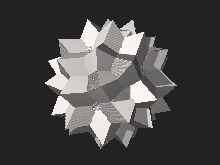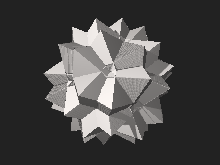Compound of ten octahedra
The compounds of ten octahedra UC15 and UC16 are two uniform polyhedron compounds. They are composed of a symmetric arrangement of 10 octahedra, considered as triangular antiprisms, aligned with the axes of three-fold rotational symmetry of an icosahedron. The two compounds differ in the orientation of their octahedra: each compound may be transformed into the other by rotating each octahedron by 60 degrees.
| Compounds of ten octahedra | |
|---|---|
  | |
| Type | Uniform compound |
| Index | UC15 and UC16 |
| Polyhedra | 10 octahedra |
| Faces | 20+60 triangles |
| Edges | 120 |
| Vertices | 60 |
| Symmetry group | icosahedral (Ih) |
| Subgroup restricting to one constituent | 3-fold antiprismatic (D3d) |

3D model of the compound of ten octahedra UC15
Cartesian coordinates
Cartesian coordinates for the vertices of this compound are all the cyclic permutations of
- (0, ±(τ−1√2 + 2sτ), ±(τ√2 − 2sτ−1))
- (±(√2 − sτ2), ±(√2 + s(2τ − 1)), ±(√2 + sτ−2))
- (±(τ−1√2 − sτ), ±(τ√2 + sτ−1), ±3s)
where τ = (1 + √5)/2 is the golden ratio (sometimes written φ) and s is either +1 or −1. Setting s = −1 gives UC15, while s = +1 gives UC16.
gollark: Maybe add a disclaimer? "By using this bot, you agree that you are to blame for literally anything it does."
gollark: ++remind 1m <@!309787486278909952> bees.
gollark: You utter apiosporoundecasulphoform!!!!
gollark: Maybe make it not ping in +>markov messages, but spontaneously generate pings instead.
gollark: ++apioform
See also
References
- Skilling, John (1976), "Uniform Compounds of Uniform Polyhedra", Mathematical Proceedings of the Cambridge Philosophical Society, 79: 447–457, doi:10.1017/S0305004100052440, MR 0397554.
This article is issued from Wikipedia. The text is licensed under Creative Commons - Attribution - Sharealike. Additional terms may apply for the media files.
